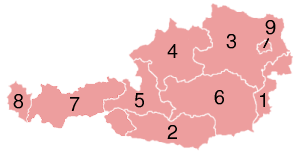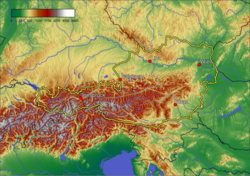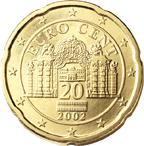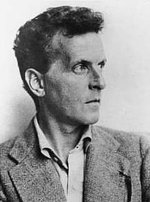Austria
|
|
The Republic of Austria (German: Republik Österreich) is a landlocked country in the heart of Europe. It borders Germany and the Czech Republic to the north, Slovakia and Hungary to the east, Slovenia and Italy to the south, and Switzerland and Liechtenstein to the west.
Austria is a parliamentary representative democracy consisting of nine federal states and is one of two European countries that have declared their everlasting neutrality. Austria is a member of UN and the European Union Template:Austria infobox
| Contents |
History
Origin of the name
The German name Österreich can be translated into English as the "eastern realm", which is derived from the Old German Ostarrîchi. The term probably originates in a vernacular translation of the Medieval Latin name for the region: Marchia orientalis, which translates as "eastern border," as it was situated at the eastern edge of the Holy Roman Empire, that was also mirrored in the name Ostmark applied after Anschluss to the Third Reich. Interestingly, the derivation of the Latin name from the original Old German gives rise to the use of "Aust-" for east, rather than south as in Classical Latin.
Austria and the Holy Roman Empire
Battle_of_Vienna.jpg
The territory of Austria was conquered by the Romans during the reign of Augustus and made a province of Rome in 16 BC. Later it was conquered by Huns, Lombards, Ostrogoths, Bavarii and Franks (in that order) until the core territory of Austria was awarded to Leopold of Babenberg in 976. Being part of the Holy Roman Empire the Babenbergs ruled and expanded Austria from the 10th to the 13th century. After Frederick II died in 1246 and left no successor, the German Emperor Rudolf I of Habsburg gave the lands to his sons marking the beginning of the line of the Habsburgs, who continued to govern Austria until the 20th century.
With the short exception of Charles VII Albert of Bavaria, Austrian Habsburgs held the position of German Emperor beginning in 1438 with Albert II of Habsburg until the end of the Holy Roman Empire. During the 14th and 15th century Austria continued to expand its territory until it reached the position of a European superpower at the end of the 15th century until the end of the Habsburg monarchy in 1918.
Modern history
After the abolition of the Holy Roman Empire in 1806, the Empire of Austria was founded, which was transformed in 1867 into the double-monarchy Austria-Hungary. The empire was split into several independent states in 1918, after the defeat of the Central Powers in World War I, with most of the German-speaking parts becoming a republic. Between 1918 and 1919 it was officially known as the Republic of German Austria (Republik Deutschösterreich), and then the name was changed to simply Republic of Austria. The democratic republic lasted until 1933 when the chancellor Engelbert Dollfuß established an autocratic regime oriented towards Italian fascism.
Austria was annexed by Germany in 1938 (the Anschluß) amongst popular acclaim. After the defeat of the Axis Powers, the Allies occupied Austria at the end of World War II in Europe until 1955, when the country again became a fully independent republic under the condition that it remained neutral (see also: Austrian State Treaty). In that year it also became a member of the UN. After the collapse of communism in Eastern Europe, Austria became increasingly involved in European affairs, and in 1995, Austria joined the European Union, and the Euro monetary system in 1999. Some Conservative politicians have suggested that Austria join NATO.
Politics
1nationalrat.jpg
Austria has been a federal, parliamentary democracy republic since the Federal Constitution of 1920, which was again reintroduced in 1945 to the nine states of the Federal Republic. The head of state is the Federal President, who is directly elected. The chairman of the Federal Government is the Federal Chancellor, who is appointed by the president and voted into office by the majority of the Nationalrat, the National Council of Austria. The government can be recalled by a vote of no confidence in the National Council.
The Austrian parliament consists of two chambers. The composition of the Nationalrat is determined every four years by a free general election in which every citizen is allowed to vote to fill its 183 seats. A "Four Percent Hurdle" prevents a large splintering of the political landscape in the Nationalrat by awarding seats only to political parties that have received at least four percent of the general vote, or alternatively, have won a direct seat, or Direktmandat, in one of the 43 regional election districts. The Nationalrat is the dominant chamber in the formation of legislation in Austria. However, the upper house of parliament, the Bundesrat has a limited right of veto (the Nationalrat can pass the respective bill a second time bypassing the Bundesrat altogether). A convention, called the Österreich Konvent [1] (http://www.konvent.gv.at/) was convened in June 30, 2003 to decide upon suggestions to reform the constitution.
Administrative divisions
A federal republic, Austria is divided into nine states, (in Austria called Bundesländer; singular Bundesland). These states are divided into districts (Bezirke) and cities (Städte) and subdivided into Gemeinden.
| In English | In German | ||
|---|---|---|---|
| State | Capital | State | Capital |
| 1 Burgenland | Eisenstadt | Burgenland | Eisenstadt |
| 2 Carinthia | Klagenfurt | Kärnten | Klagenfurt |
| 3 Lower Austria | St. Pölten | Niederösterreich | St. Pölten |
| 4 Upper Austria | Linz | Oberösterreich | Linz |
| 5 Salzburg (state) | Salzburg | Salzburg (Land) | Salzburg |
| 6 Styria | Graz | Steiermark | Graz |
| 7 Tyrol | Innsbruck | Tirol | Innsbruck |
| 8 Vorarlberg | Bregenz | Vorarlberg | Bregenz |
| 9 Vienna (state) | Vienna | Wien (Land) | Wien |
Geography
Large parts of Austria are mountainous due to its location in the Central Eastern Alps, which can be subdivided into the Tirolean Alps, the High and Low Tauern, Northern Limestone Alps, Southern Limestone Alps, and the Wienerwald.
Austria's territory stretches from the high mountains of the Alps in the west of the country to the low and plain fields of the East. It may be divided into 5 different areas with the biggest portion constituting the Austrian Alps with 62 percent of total Austria (Out of the total area of Austria (84,000 km²) only about a quarter can be considered low lying, and only 32 percent of the country is below 500 metres). The Austrian foothills of the Alps and the Carpathians account for around 12 percent of its landmass with the foothills in the East and Austrian area around the periphery of the Pannoni low country amounting to approximately another 12 percent. The second greater mountain mass (much lower than the Alps) is situated in the North, the Austrian granite plateau, located in the central mountainous area of the Bohemian Mass accounting for 10 percent of Austria and last the Austrian portion of the Viennese basin for 4 percent.
Climate: The greater part of Austria lies in the cool/temperate climatic zone in which humid westerly winds predominate. With over half of the country dominated by the Alps the alpine cimate is the predominate one. In the East the climate shows continental features with less rain than the Western alpine areas with high rainfall averages.
43grossglockner.jpg
The six highest mountains in Austria are:
| Name | Height | Range | |
|---|---|---|---|
| 1 | Großglockner | 3.797 m | High Tauern |
| 2 | Wildspitze | 3,768 m | Ötztal Alps |
| 3 | Weißkugel | 3,739 m | Ötztal Alps |
| 4 | Großvenediger | 3,674 m | High Tauern |
| 5 | Similaun | 3,606 m | Ötztal Alps |
| 6 | Wiesbachhorn | 3,571 m | High Tauern |
Economy
Main article: Economy of Austria
Austria has a well-developed social market economy and a high standard of living. Until the 1980s many of Austria's largest industry firms were nationalized, however in recent years privatization has reduced state holdings to a level comparable to other European economies. Labour movements are particulary strong in Austria and have large influence on labour politics.
Especially Germany is and historically has been for a long time the main trading partner of Austria, making it vulnerable for rapid changes in the German economy. Slow growth in Germany and elsewhere in the world affected Austria, slowing its growth to 1.2% in 2001. But since Austria became a member state of the European Union it has gained closer ties to other European Union economies, on the other side reducing its economic dependence on Germany. In addition, membership in the EU has drawn an influx of foreign investors attracted by Austria's access to the single European market and proximity to EU aspirant economies. Therefore estimates of growth in 2005 (up to 2 %) are much more favourable than in the crippling German economy.
Agriculture: Austrian farms, like those of other west European mountainous countries, are small and fragmented, and production is relatively expensive.
Industry: Although some industries, such as several iron and steel works and chemical plants, are large industrial enterprises employing thousands of people, most industrial and commercial enterprises in Austria are relatively small on an international scale.
Services: Like in other western countries, the biggest contributor to Austrias's GDP is its service sector. Most notably is tourism, especially winter tourism.
To meet increased competition from both EU and Central European countries, Austria will need to emphasize knowledge-based sectors of the economy, continue to deregulate the service sector, and lower its tax burden.
See also: List of Austrian companies
Demographics
Main article: Demographics of Austria
Austria's capital Vienna is one of Europe's major cities with a population exceeding 1.6 million (2 million with suburbs) and constitutes a meltingpot comparable in diversity to New York with citizens from all over Central and Eastern Europe. In contrast to this Metropolis, other cities do not exceed 1 million inhabitants, in fact the second largest city Graz is home of only 305.000 people (followed by Linz with 180.000, Salzburg with 145.000 and Innsbruck with 120.000). All other cities have less than 100.000 inhabitants.
Austrians of German mother tongue, by far the country's largest ethnic group, form between 85% and 89% of Austria's population. Around ten percent of Austria's people are of non-Austrian descent, many from surrounding countries, especially from the former East Bloc nations. The Austrian federal states of Carinthia and Styria are home to a significant (indigenous) Slovenian minority with around 14,000 members (official census; inofficial numbers of Slovene organisations speak of about 40,000). So-called guest workers (Gastarbeiter) and their descendants also form an important minority group in Austria. Around 20,000 Hungarians and 30.000 Croatians live in the east-most Bundesland, Burgenland. (Formerly part of Hungary.)
The official language, German, is spoken by almost all residents of the country. Austria's mountainous terrain led to the development of many distinct German dialects. All of the dialects in the country, however, belong to Austro-Bavarian groups of German dialects, with the exception of the dialect spoken in its west-most Bundesland, Vorarlberg, which belongs to the group of Alemannic dialects.
There is also a distinct grammatical standard for Austrian German with a few differences to the German spoken in Germany.
Religion
73.6% of the native population identify themselves as Roman Catholic, while 4.7% consider themselves Protestant. About 12% of the population does not belong to any church or religious community. Of the remaining people, about 180,000 are members of the Eastern Orthodox Church, about 7,300 are Jewish, and around 300,000 are members of various Muslim religious communities. Prior to the Holocaust, about 200,000 Jews lived in Austria.
Austrian culture
Main article: Culture of Austria
Although Austria is a small country, its history as a world power and unique cultural environment in the heart of Europe have generated contributions to mankind in every possible field. Austria is presumably internationally best known for its musicians. It has been the birthplace of many famous composers such as Wolfgang Amadeus Mozart, Joseph Haydn, Franz Schubert, Anton Bruckner, Johann Strauss, Sr., Johann Strauss, Jr. or Gustav Mahler as well as members of the Second Viennese School such as Arnold Schoenberg, Anton Webern or Alban Berg.
Complementing its status as a land of artists, Austria has always been a country of great poets, writers and novelists. It was the home of novelists Arthur Schnitzler, Franz Kafka, Stefan Zweig, Thomas Bernhard or Robert Musil, of poets Georg Trakl, Franz Werfel, Franz Grillparzer, Rainer Maria Rilke or Adalbert Stifter. Famous contemporary playwrights and novelists are Elfriede Jelinek and Peter Handke. Among Austrian artists and architects one can find painters Gustav Klimt, Oskar Kokoschka, Egon Schiele or Friedensreich Hundertwasser, photographer Inge Morath or architect Otto Wagner.
Austria was the cradle of numerous scientists including physicists Ludwig Boltzmann, Lise Meitner, Erwin Schrödinger, Ernst Mach, Wolfgang Pauli, Richard von Mises and Christian Doppler, philosophers Ludwig Wittgenstein and Karl Popper, biologists Gregor Mendel and Konrad Lorenz as well as mathematician Kurt Gödel. It was home to psychologists Sigmund Freud, Alfred Adler, Paul Watzlawick and Hans Asperger, psychiatrist Viktor Frankl, economists Joseph Schumpeter, Eugen von Böhm-Bawerk, Ludwig von Mises, and Friedrich Hayek (Austrian School), and engineers such as Ferdinand Porsche and Siegfried Marcus.
Although Austrians can look back with pride on their cultural past, current Austria does not stand back in art and science. Austria hosts a tremendous amount of culture, with its classical music festivals in Vienna, Salzburg and Bregenz, its modern artists and writers, its theatres and opera houses.
Miscellaneous topics
- Austrian folk dancing
- Spanish Riding School
- Austrian Food
- Communications in Austria
- Transportation in Austria
- Military of Austria
- Education in Austria
- Foreign relations of Austria
- Austria/Language
- Tourism in Austria
- Stamps and postal history of Austria
- Public holidays in Austria
References
- References and bibliography can be found in the more detailed articles linked to in this article
External links
- - About Austria (http://www.aboutaustria.org) Austrian Tourist, Travel and Culture Guide
- Austrian Cultural Forum New York (http://www.acfny.org) Cultural meeting place in Manhattan
- Answers.com (http://www.answers.com/austria) Article on Austria
- US Department of State (http://www.state.gov/r/pa/ei/bgn/3165.htm) Facts and Information (updated February 2005)
- Bundeskanzleramt.at (http://www.bundeskanzleramt.at/) Website of the Federal Chancellery of Austria (German, English)
- Austria.info (http://www.austria.info/) Official homepage of the Austrian National Tourist Office (German, English and other languages)
- Tiscover.at (http://www.tiscover.at/) Austria travel guide
- Travel Anytravels.com (http://www.anytravels.com/europe/austria/) Travel-Information about Austria
- Dwellan.com (http://www.dwellan.com/documents/links_at_en.html) Tourism in Austria
- Willgoto Austria (http://www.willgoto.com/categories.aspx?Destination=217&Langue=1) Travel guide and directory
- Library of Congress (http://www.loc.gov/rr/international/european/austria/au.html) Portals on the World - Austria
- Cia.gov (http://www.cia.gov/cia/publications/factbook/geos/au.html) CIA's Factbook on Austria
- Photoglobe.info (http://www.photoglobe.info/ebooks/austria/) Country Studies - Austria Info
- Austrosearch (http://www.austrosearch.at/) Bilingual Austrian Search engine and Directory (German, English)
- Peter Diem (http://peter-diem.at/default_e.htm) The Symbols of Austria
- Austria in Pictures (http://austria.europe-countries.com)
- Radio-ORF (http://radio.orf.at/) Austrian Radio stations - both classical and modern music (live feed)
- Amateur Radio in Austria (http://www.oevsv.at)
- Earth-photography.com (http://www.earth-photography.com/Countries/Austria) Photos of Austria
| | Missing image European_flag.png Flag of the European Union |
|---|---|
|
Austria | Belgium | Cyprus | Czech Republic | Denmark | Estonia | Finland | France | Germany | Greece | Hungary | Ireland | Italy | Latvia | Lithuania | Luxembourg | Malta | Netherlands | Poland | Portugal | Slovakia | Slovenia | Spain | Sweden | United Kingdom | |
| Countries in Europe |
|---|
| Albania | Andorra | Austria | Azerbaijan1 | Belarus | Belgium | Bosnia and Herzegovina | Bulgaria | Croatia | Cyprus2 | Czech Republic | Denmark | Estonia | Finland | France | Germany | Greece | Hungary | Iceland | Ireland | Italy | Latvia | Liechtenstein | Lithuania | Luxembourg | Macedonia | Malta | Moldova | Monaco | Netherlands | Norway | Poland | Portugal | Romania | Russia1 | San Marino | Serbia and Montenegro | Slovakia | Slovenia | Spain | Sweden | Switzerland | Turkey1 | Ukraine | United Kingdom | Vatican City |
| Dependencies: Akrotiri and Dhekelia2 | Faroe Islands | Gibraltar | Guernsey | Jan Mayen | Jersey | Isle of Man | Svalbard |
| 1. Country partly in Asia. 2. Usually assigned to Asia geographically, but often considered European for cultural and historical reasons. |
Template:States of Austriafur:Austrie
ang:Éastríce
ar:نمسا
an:Austria
ast:Austria
bg:Австрия
be:Аўстрыя
bn:অস্ট্রিয়া
bs:Austrija
ca:Àustria
cs:Rakousko
cy:Awstria
da:Østrig
de:Österreich
et:Austria
el:Αυστρία
als:Österreich
es:Austria
eo:Aŭstrio
fa:اتریش
fr:Autriche
fy:Eastenryk
ga:An Ostair
gd:An Ostair
gl:Austria - Österreich
ko:오스트리아
hi:ऑस्ट्रिया
hr:Austrija
io:Austria
id:Austria
ia:Austria
is:Austurríki
it:Austria
he:אוסטריה
ka:ავსტრია
kw:Estrych
la:Austria
lv:Austrija
lt:Austrija
lb:Éisträich
li:Oosteriek
hu:Ausztria
mk:Австрија
mt:Awstrija
ms:Austria
zh-min-nan:Tang-kok
na:Austria
nl:Oostenrijk
nds:Österriek
ja:オーストリア
no:Østerrike
pl:Austria
pt:Áustria
ro:Austria
rm:Austria
ru:Австрия
se:Nuortariika
sq:Austria
simple:Austria
sk:Rakúsko
sl:Avstrija
sr:Аустрија
fi:Itävalta
sv:Österrike
th:ประเทศออสเตรีย
tl:Austria
vi:Áo
tr:Avusturya
uk:Австрія
zh:奥地利





